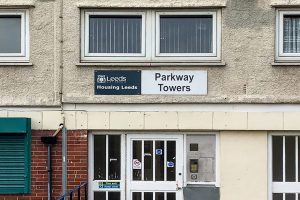The Role of Community Spaces in Inner City Areas
The lack of community spaces in inner city areas has become a significant issue in recent years, affecting the quality of life and wellbeing of local residents. Even as more housing is being built outside the city centre, other amenities are disappearing, leaving people feeling disconnected from their community and each other. So what can we as a community arts organisation do about it?

“If there’s nowhere for the community to meet, then there’s no community.” This is a quote from a film we made with the tenants of Parkway Towers in Seacroft about their aim to develop a community space in their tower block, supported by Zest and Space2. It emphasises the significance of local meeting spaces for residents and echoes similar conversations we’ve had with other people and organisations across the city.
Community spaces play a crucial role in providing residents with a sense of belonging and identity. They offer a place for people to connect, socialise and engage in activities, fostering a sense of community spirit and shared purpose. The shortage of these spaces has created an environment where people are less able to interact with their neighbours, resulting in a steep rise in loneliness and a decline in overall quality of life for many residents.
Another challenge is the scarcity of space for small not-for-profit organisations like ourselves. There are many similar organisations in the city and we all play a crucial role in bridging the gaps in services and resources that the local government can’t always provide. We work creatively to find solutions to local needs, but the lack of available space can make it difficult for us to operate effectively, limiting our ability to provide events, such as educational workshops and recreational activities.
Community spaces in inner city areas provide numerous positive effects, not only on the wellbeing of residents but also on the local economy, health outcomes, and educational attainment. As a safe space to learn and play, these venues can act as a hub for people to find or create new opportunities for themselves and others. Conversely, the absence of community spaces contributes to inequality. Inner city areas are often home to low-income and disenfranchised communities who already face social and economic challenges. Without access to spaces to meet, residents are further marginalised, exacerbating existing inequalities.
We believe that local authorities should prioritise the provision of community spaces, potentially through the repurposing of existing buildings, with support from the corporate and community sector. Councils can also work with organisations and residents to ensure that these spaces are accessible and responsive to the needs of local people. The Highrise Project are currently developing a proposal to bring together a consortium for a creative community space in Armley. If you are a small creative organisation who work with communities and would like to chat about a shared space, please get in touch with us at thehighriseprojectleeds@gmail.com.
